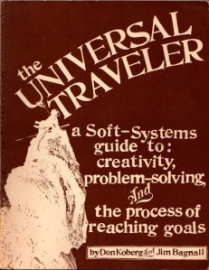Ooh, The Universal Traveler
A super weird chain of events landed this book –

The Universal Traveler: A Soft-Systems Guide to: Creativity, Problem-Solving, and the Process of Reaching Goals – in my hands. It was published in 1972, so you know what this means – typewritten text, rubber stamped headings, and collage for graphics. Oh yes. And the second author, Jim Bagnall, calls himself a graphic coordinator and has this to say for his bio line: “He sees his role as that of visually simplifying the complexities of life.” Oh hell yes. Could it get better? THERE IS A SECTION ON EVALUATION. Giddiness hardly explains my state.
Travel, in this sense, is the systematic inquiry into just about anything. The authors propose that preparing oneself to travel with logic and creativity (yes, both), a good design, and some operationalization will equip one for any journey.
And the basic function of embarking on this journey is to “free us from uncertainty, anxiety, confusion and other insecurities.” Sounds A LOT like what evaluators hope to do for clients (only stated with more eloquence). In fact, the whole journey process they outline is, itself, a process of evaluation, though they only call the final step “evaluate.” And in this book, the final “evaluate” step is much more laid back and mellow than the typical evaluation journeys I am on. So the methods they list might seem less-than-rigorous, such as writing a letter to a friend. Evaluation in their use of the term comes across as more of a debrief than a systematic process in and of itself.

In fact, the seven step process of taking a journey is much more akin to the systematic process we typically think of as evaluation:
1. Accept situation
2. Analyze
3. Define
4. Ideate
5. Select [appropriate methods]
6. Implement
7. Evaluate
You’ll have to check out page 20 to see this process laid out in several types of rubber-stamp-and-pencil logic models. From 1972. So awesome.
So even if their idea of evaluation is more of a thought exercise, their process as a whole reminds us professionals to lighten up a
little so there’s room for the creativity needed to push ourselves and our field to new heights. Ultimately, The Ultimate Traveler proves that it is possible to be both logical and cool. In fact, both appear to be critical to growth.

__
Apparently its popularity is not contained here in my chair – the most recent edition was published in 2003 and Amazon carries copies.

